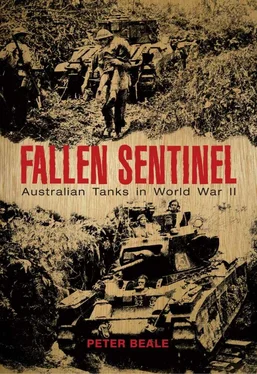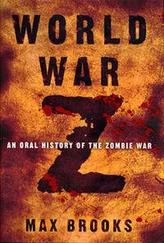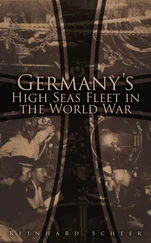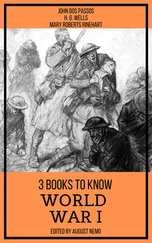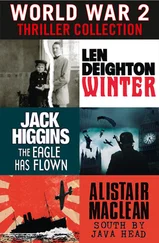In the 1914–18 war, a very large contingent of Australians fought overseas at Gallipoli, in northern France and Belgium and in Palestine. At that time there appeared to be no significant threat to the Australian mainland. China was hopelessly disorganised, Japan was an ally and all the other countries in the South-west Pacific were colonies of France, Holland, or Britain. The number of troops required for the defence of Australia was relatively small.
From 1919 to 1939 both Britain and Australia were confronted with the problem of maintaining armed forces capable of achieving the three tasks. While the Navy and Air Force had substantial roles to play, the focus of this book is the Army. What sort of army would be required to fulfil the three roles and how should it be employed? The answer to this question will necessarily involve analysis of the part to be played by a tank force in that army.
Because the Australian Army had no significant tank arm prior to 1939, the British Army’s tank doctrine formed the basis for Australian doctrine. British Army doctrine evolved gradually and continuously and was largely influenced by two significant events: the experiences of the Great War and the advances in technology in the period after 1919, particularly the mechanisation of transport and the development of radio communication.
The first element of British Army doctrine was, in the words of the Chief of the Imperial General Staff (CIGS), Sir George Milne, in 1933, ‘succeeding without incurring losses.’ 1Following the horrendous loss of life in the Great War, the High Command pledged to do all it could to preserve soldiers’ lives in any future conflict. The best way to achieve this was to provide maximum firepower so that enemy fire would be suppressed during the final yards of an infantry assault on a position. Artillery could provide the indirect fire and tanks the direct.
The second element of Army doctrine was mobility. Tanks were naturally mobile over a variety of terrain and mechanisation would provide similar mobility for the infantry. They could have trucks for their supplies and armoured vehicles could be provided to take them close to the battlefield.
The third element was the combination of arms. The High Command came to realise in 1917 and 1918 that ‘success depended on the intelligent cooperation of all arms to overwhelm the defenders by weight of fire and enable the infantry to attack without incurring unacceptably high losses.’ 2This doctrine was promulgated throughout all levels of the Army.
The combination of arms could have included the Air Force, as it did in Monash’s victory at Hamel in 1918. But having established itself as a separate service, the RAF was reluctant to provide any close support to the Army, claiming that its main role was strategic bombing. 3This presents an unfortunate contrast to the German Army’s devastating use of the Stuka in close support in 1939 and1940. 4
A fourth element proved to be a major hindrance in implementing the other three. The British Army’s command and control system effectively impeded the full exploitation of mobility on the battlefield. Orders were issued in considerable detail and the process filtered down through all levels of the military hierarchy. The orders of a higher level of command were to be followed rigidly by the lower levels, and any deviation from the original plan had to be referred upwards for approval.
Such a process obviously took time and inhibited junior commanders from acting on their initiative. The delay in resuming action meant that tactical opportunities were often lost and subsequent advances met stronger opposition. The system was significantly inferior to the German aufträgstaktik system, in which a junior commander knew his superior’s mission and could take any action to achieve that mission. 5
British Army doctrine also formed the basis for its tank doctrine. That doctrine was initiated in a primitive way as soon as tanks first went into action in 1916. It was progressively subjected to change, stemming from experience, improved equipment, and the personal views of those who could influence the formulation of doctrine.
Tanks in World War I
During the First World War the aeroplane and the tank were used for the first time as weapons of war and their performance developed and improved rapidly. The aeroplane had been produced prior to the First World War, but the tactics for its use as a military weapon had not been formulated in any detail and had to be developed as the war progressed. Its principal roles were reconnaissance, the support of ground forces, and bombing military and other objectives.
The tank was the second major new weapon of war. The concept of the tank was developed during 1915 and 1916, and was first used on 15th September 1916, two years after the beginning of the war. 6The tank was primarily employed during two distinct periods, the first from 15 September 1916 to 20 November 1917. uring this period it was used in piecemeal fashion and suffered a variety of setbacks.
These setbacks stemmed partly from the mechanical condition of the tanks, which resulted in frequent breakdowns and from the environment in which the tank crews had to operate. David Fletcher writes:
The conditions inside the tank were almost impossible to imagine. The noise and heat from the engine dominated and it was quite impossible to hear anything else while it was running. The big engine also tended to leak exhaust fumes from joints in the manifold and exhaust stacks. Although the air inside the tank was always on the move, the amount of carbon dioxide swirling about inside the hull was enough to choke on.
Bearing in mind that parts of the engine and adjacent plumbing were too hot to touch and that without springs every bump in the ground was transmitted through the tracks and rollers to the hull and thence the crew, you have a recipe for severe discomfort. To make matters worse the petrol supply placed the crew in extreme danger. Fuel was carried in tanks located in the frames on either side of the cab. Supply to the carburettor was by gravity and it could fail if the tank stalled nose down in a trench. The risk of fire was ever present and if the fuel ignited, either by accident or by an incoming shell, the chances of all eight men of the crew getting out unscathed were slim. 7
These conditions created such a poisonous atmosphere within the tank that, after a day’s fighting, even the most ardent crews were almost incapable of further action for another twenty-four hours. There was also some uncertainty in the minds of senior Army officers as to exactly how the tanks should be used. Those hardy souls who manned the tanks were likewise unclear as to the tank’s most effective role.
One of the crews who took part in the first battle on 15 September 1916 described his experience: ‘My crew and I did not have a tank of our own the whole time we were in England. Ours went wrong the day it arrived. We had no reconnaissance or map reading, no practices or lectures on the compass, we had no signalling, and no practice in considering orders. We had no knowledge of where to look for information that would be necessary for us as tank commanders, nor did we know what information we should be likely to require.’ 8
It is surprising, in the light of this lack of training and instruction, that the tanks were able to perform at all. But in the period September 1916 to November 1917 they performed effectively on several occasions, although generally in small numbers. They also performed very ineffectively on a number of occasions, discouraging the infantry from gaining any confidence over the assistance that tanks might be able to lend them. 9
The second period of tank use began on 20 November 1917 with the Battle of Cambrai. 10This battle demonstrated the effectiveness of tanks used en masse and in reasonable terrain. The lessons of Cambrai generated much greater confidence in the use of tanks, both in the soldiers they were supporting, and in the Army commanders. The result was to accelerate the flow of tanks to the armies in France.
Читать дальше
